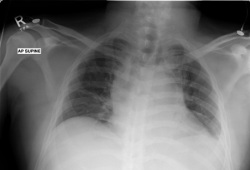Summary
Definition
History and exam
Key diagnostic factors
- presença de fatores de risco
- linfadenopatia
Other diagnostic factors
- febres não explicadas
- sudorese noturna
- perda de peso
- dispneia
- tosse
- dor torácica
- síndrome da veia cava superior (SVCS)
- dor abdominal
- prurido
- dor induzida por álcool nos locais afetados
- hepatomegalia e/ou esplenomegalia
- aumento tonsilar
Risk factors
- 20-34 anos e >55 anos de idade
- história de infecção por vírus Epstein-Barr (EBV)
- história familiar de linfoma de Hodgkin
- adultos jovens de classe socioeconômica mais alta
- tipos de antígeno leucocitário humano (HLA)
- ascendência judaica
Diagnostic tests
1st tests to order
- Hemograma completo com diferencial
- perfil metabólico completo
- velocidade de hemossedimentação (VHS)
- testes da função tireoidiana
- rastreamento para HIV, hepatite B, hepatite C
- radiografia torácica
- tomografia por emissão de pósitrons/tomografia computadorizada (PET/TC)
- TC com contraste (pescoço, tórax, abdome, pelve)
- biópsia excisional de linfonodos ou punção por agulha grossa (core biopsy)
- estudos imuno-histoquímicos
Tests to consider
- biópsia da medula óssea
- ecocardiograma ou angiografia sincronizada multinuclear (MUGA)
- testes de função pulmonar
Treatment algorithm
LH clássico inicial (estádio I a II): doença favorável e destinado à terapia de modalidade combinada
LH clássico inicial (estádio I a II): doença favorável e destinado à quimioterapia isolada
LH clássico inicial (estádio I a II): doença desfavorável (volumosa ou não volumosa) e destinado à terapia de modalidade combinada
LH clássico inicial (estádio I a II): doença desfavorável (não volumosa) e destinado à quimioterapia isolada
LH clássico inicial (estádio I a II): doença desfavorável (volumosa) e destinado à quimioterapia isolada
LH clássico inicial (estágio I a II): doença desfavorável e indicada para terapia de indução alternativa
LH clássico avançado (estádio III a IV): destinado à quimioterapia de indução intensiva
LH clássico avançado (estádio III a IV): destinado à terapia de indução padrão (quimioimunoterapia)
LH clássico avançado (estádio III a IV): destinado à terapia de indução padrão (quimioterapia)
LHPLN assintomático inicial (estádio IA a IIA), doença não volumosa
LHPLN assintomático inicial (estádio IA a IIA), doença volumosa; e LHPLN sintomático inicial (estádio IB a IIB)
LHPLN avançado (estádio III a IV)
LH clássico refratário ou recidivante
LHPLN refratário ou recidivante
Contributors
Authors
Alison Moskowitz, MD
Associate Attending
Lymphoma Service
Memorial Sloan-Kettering Cancer Center
New York City
NY
Disclosures
AM has received research support from ADC Therapeutics, Beigene, Miragen, Seattle Genetics, Merck, Bristol-Myers Squibb, Incyte, and SecuraBio. AM has received honoraria from Seagen, Affimed, Astra Zeneca, Bio Ascend, Imbrium Therapeutics L.P./Purdue, Janpix Ltd., Merck, Seattle Genetics, Pfizer, Tessa Therapeutics and Takeda. AM is an author of several references cited in this topic.
Acknowledgements
Dr Alison Moskowitz would like to gratefully acknowledge Dr Chris R. Kelsey, Dr Leonard R. Prosnitz, and Dr Timothy M. Zagar, the previous contributors to this topic.
Disclosures
CRK, LRP, and TMZ declare that they have no competing interests.
Peer reviewers
Snegha Ananth, MBBS
Assistant Professor
Division of Oncology & Hematology
University of Nebraska Medical Center
Omaha
NE
Disclosures
SA declares that she has no competing interests.
Christopher D'Angelo, MD
Assistant Professor
Division of Oncology & Hematology
University of Nebraska Medical Center
Omaha
NE
Disclosures
CDA declares that he has received consulting fees from Abbvie, Beigene, Genmab, Curis Inc, Bristol Myers Squibb.
Peer reviewer acknowledgements
BMJ Best Practice topics are updated on a rolling basis in line with developments in evidence and guidance. The peer reviewers listed here have reviewed the content at least once during the history of the topic.
Disclosures
Peer reviewer affiliations and disclosures pertain to the time of the review.
References
Key articles
Cheson BD, Fisher RI, Barrington SF, et al. Recommendations for initial evaluation, staging, and response assessment of Hodgkin and non-Hodgkin lymphoma: the Lugano classification. J Clin Oncol. 2014 Sep 20;32(27):3059-68.Full text Abstract
National Comprehensive Cancer Network. NCCN clinical practice guidelines in oncology: Hodgkin lymphoma [internet publication].Full text
Eyre TA, Cwynarski K, d'Amore F, et al. Lymphomas: ESMO clinical practice guideline for diagnosis, treatment and follow-up. Ann Oncol. 1 Aug 2025:S0923-7534(25)00911-1.Full text Abstract
Follows GA, Barrington SF, Bhuller KS, et al. Guideline for the first-line management of classical Hodgkin lymphoma - a British Society for Haematology guideline. Br J Haematol. 2022 Jun;197(5):558-72.Full text Abstract
McKay P, Fielding P, Gallop-Evans E, et al. Guidelines for the investigation and management of nodular lymphocyte predominant Hodgkin lymphoma. Br J Haematol. 2016 Jan;172(1):32-43.Full text Abstract
Reference articles
A full list of sources referenced in this topic is available to users with access to all of BMJ Best Practice.

Differentials
- Linfoma não Hodgkin (LNH)
- Linfadenopatia oriunda de outras malignidades
- Mononucleose infecciosa
More DifferentialsGuidelines
- NCCN clinical practice guidelines in oncology: Hodgkin lymphoma
- Suspected cancer: recognition and referral
More GuidelinesLog in or subscribe to access all of BMJ Best Practice
Use of this content is subject to our disclaimer